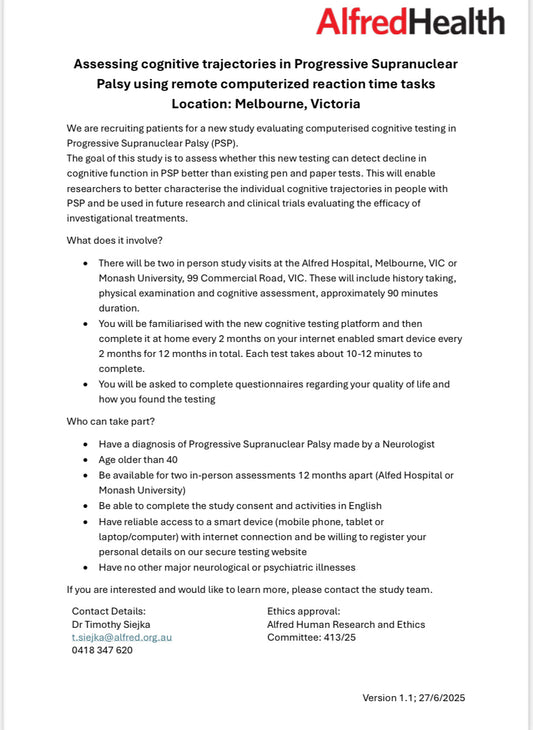The journey to a Parkinson's disease (PD) diagnosis can be fraught with uncertainties, especially when the symptoms mimic those of other neurodegenerative disorders. Atypical parkinsonism, often referred to as "Parkinson's Plus" syndromes, includes conditions like Multiple System Atrophy (MSA), Progressive Supranuclear Palsy (PSP), Corticobasal Degeneration (CBD), and Dementia with Lewy Bodies (DLB). This blog post delves into the real-life stories of misdiagnosis, the diagnostic odyssey, and the profound implications for those whose initial Parkinson's diagnosis was later revised to an atypical form.
The Diagnostic Journey
Case Study 1: From Parkinson's to MSA
Initial Diagnosis: John, a 58-year-old retired teacher, began experiencing tremors and stiffness. His general practitioner diagnosed him with Parkinson's disease, and he was started on levodopa, which initially seemed to help.
Symptoms Evolution: After a year, John's symptoms didn't follow the expected pattern. He developed severe urinary problems and orthostatic hypotension, symptoms less common in early PD.
Reevaluation: A neurologist, specialized in movement disorders, noticed the lack of response to typical PD treatments and ordered further tests. An MRI showed characteristic findings suggestive of MSA, including atrophy in the putamen.
Implications: The misdiagnosis led to a year of inappropriate treatment. With the correct diagnosis, John's treatment shifted to managing autonomic symptoms, significantly impacting his quality of life.
Case Study 2: The PSP Misdiagnosis
Initial Diagnosis: Helen, aged 62, was diagnosed with Parkinson's after presenting with gait instability and mild cognitive changes. She began levodopa treatment but experienced minimal improvement.
Diagnostic Clues: Over time, Helen's symptoms included frequent backward falls, difficulties with eye movements, particularly looking down, and a lack of tremor, which is less common in PD.
Re-diagnosis: A second opinion from a neurologist familiar with atypical parkinsonism confirmed PSP through a combination of clinical signs and imaging showing midbrain atrophy.
Impact: The delay in diagnosis meant Helen and her family were unprepared for the rapid progression and unique challenges of PSP, like the need for visual aids and fall prevention.
Challenges in Diagnosis
Symptom Overlap: Atypical parkinsonism shares many symptoms with PD, particularly in the early stages. Tremors, bradykinesia, and rigidity can be present but might not respond to PD medications.
Lack of Definitive Tests: Currently, there isn't a single test to differentiate PD from atypical forms conclusively. Diagnosis often relies on clinical judgment, response to treatment, and sometimes, advanced imaging like DaTscan or MRI.
The Role of Time: Many cases require a longitudinal assessment. Atypical forms often show a quicker progression or additional symptoms not typical of PD, like autonomic dysfunction or early cognitive decline.
Therapeutic Trials: One diagnostic strategy involves observing the response to levodopa. A poor or brief response might suggest an atypical form.
The Implications of Misdiagnosis
Emotional and Psychological Impact: The emotional toll of a misdiagnosis can be profound. Patients and families undergo a second wave of shock and adjustment upon learning the true nature of the condition.
Treatment Adjustments: Treatment for PD focuses heavily on dopamine replacement, which is less effective for atypical parkinsonism. Correct identification leads to symptom-specific management, like addressing autonomic symptoms in MSA or eye movement issues in PSP.
Prognostic Clarity: Knowing the exact condition allows for better planning, from daily life adjustments to end-of-life care discussions.
Research and Clinical Trials: Accurate diagnosis is crucial for participating in the right clinical trials, which are often specific to the type of parkinsonism.
Community and Support: Misdiagnosis can initially lead to joining the wrong support groups, which might not address the specific needs of atypical parkinsonism patients.
Moving Forward
Education for Clinicians: Increasing awareness among general practitioners and neurologists about the nuances of atypical parkinsonism can reduce misdiagnosis rates.
Advancing Diagnostics: Ongoing research into biomarkers, imaging techniques, and even genetic markers could lead to earlier and more accurate diagnoses.
Patient Advocacy: Encouraging patients to seek a second opinion, especially from a movement disorder specialist, can be pivotal.
Community Engagement: Building stronger, condition-specific support networks helps those affected to navigate their particular challenges more effectively.
The stories of John, Helen, and countless others highlight a critical aspect of neurological care: the need for precision in diagnosis. When Parkinson's isn't Parkinson's, the journey can be confusing and disheartening, but with the right diagnosis, comes the possibility of tailored treatment, better support, and a clearer understanding of what lies ahead. As research progresses, we move closer to a world where such misdiagnoses are the exception rather than the rule, offering hope and better outcomes for all affected by these complex conditions.
Please note: The cases mentioned are hypothetical but based on common scenarios described in various medical literature. Always consult healthcare professionals for accurate medical advice and diagnosis.


 Donate
Donate



